 |
ROBERTS R55 - U.K. 1954 |
 |
|
|
|||||
|
|
Description Restoration Schematics |
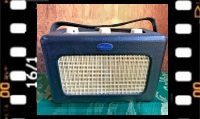 |
Descrizione Restauro Schemi |
|
|
|
|
|||||
 |
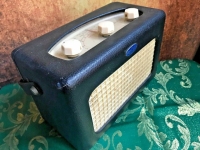 |
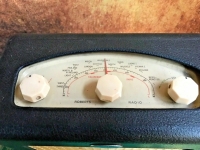 |
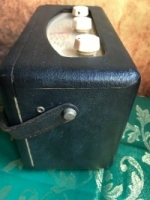 |
||
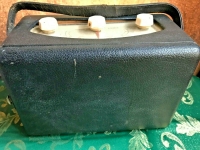 |
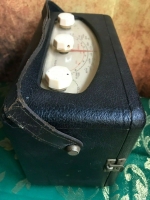 |
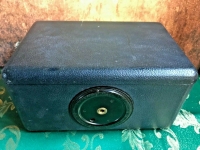 |
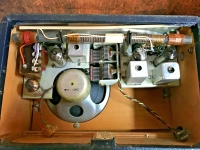 |
||
 Roberts
R55 - Great Britain 1954. Roberts
R55 - Great Britain 1954.Portable tube receiver for Medium and Long Waves built and marketed from the mid-1950s by Roberts Radio Co.Ltd. Great Britain (UK). The circuit is a superheterodyne using four Mullard miniature seven-pin valves: DK96, DF96, DAF96 and DL96. Power is supplied by two dry batteries: a 1.5 V AD4 type for the filaments arranged in parallel and a 90 V B126 type for the anode voltage. The antenna is ferroxcube and is directional, by rotating the radio in a position orthogonal to the transmitter, the best signal reception is obtained. To facilitate the operation, a double plastic disc is installed under the base of the receiver which, once placed the radio on a flat surface, allows for easy rotation. The reception range is 182 - 580 m for Medium Wave and 900 - 2000 m for Long Wave. The acoustic performance of the radio is excellent thanks to the wooden cabinet covered with imitation leather and the five-inch, 2.8 Ohm impedance Rola speaker. Two plastic labels are glued inside the cabinet: one on the rear cover shows the serial number which in the example in my possession is 2221, the other label is glued under the battery compartment and certifies that the Roberts firm paid royalties for the license to receive public radio broadcasts. IK3HIA © 2023 |
|||||
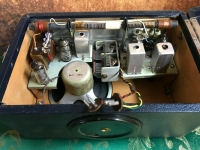 |
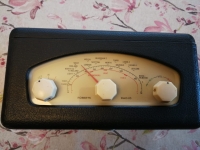 |
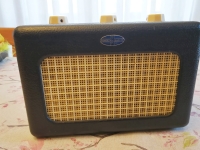 |
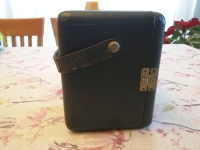 |
||
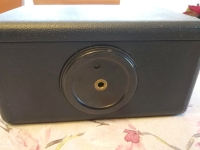 |
 |
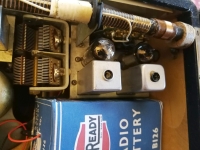 |
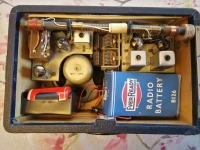 |
||
|
Back to the top of the page |
|||||
 Restoration
RestorationThe radio actually worked, the valves (DK96, DF96, DAF96 and DL96) once tested with the TV-7U tube tester were all efficient. For peace of mind and given the age of the device, I replaced the two electrolytic capacitors C19 and C20 (20 μF and 8 μF) respectively with one of 33 μF and one of 10 μF, both 300 V. On this occasion, since I had removed the chassis from the cabinet I proceeded to remove the dust from the loudspeaker and clean the front grille. I treated the volume pot and the range change switch with contact cleaner spray, then once I reassembled the unit, I fed it with my multi-voltage power supply to check its function and I was pleased to see that it was receiving a nearby station in Medium Wave with strong and clear signal. To complete the job and restore portability to the R55, all I had to do was find the right batteries to power it. Obviously the AD4 and B126 dry cells have not been marketed for almost half a century, so I had to make do. For low voltage the solution was relatively easy, in fact I was able to buy a double 1.5V type D flashlight battery holder which I modified so that it contained the batteries in parallel rather than in series. But then I only put one in because the radio actually worked great on 1.5V even with just one battery. For the high voltage the matter was a bit more laborious, but once I found in internet a drawing and the physical measurements of an Ever Ready B126 battery I proceeded to print it on cardboard, cut it out, fold it and glue the edges and I obtained a rectangular box where I managed to cram 10 x 9 V alkaline batteries type 6LR61 connected in series for a total of 90 V. You have to be careful not to touch the wires, the 6LR61 are small batteries, but 10 connected in series are capable of causing a painful shock! Once I connected all the batteries with makeshift connectors and respecting the correct polarities, the radio immediately worked perfectly, and I was able to tune in various Medium Wave stations with satisfaction. IK3HIA © 2023 |
|||||
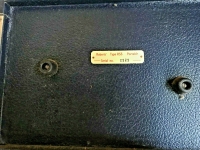 |
 |
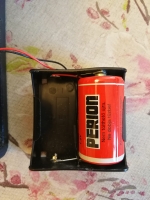 |
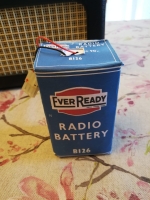 |
||
 Roberts R55 - Gran Bretagna 1954.
Roberts R55 - Gran Bretagna 1954.Ricevitore portatile a valvole per Onde Medie e Lunghe costruito e commercializzato dalla metà degli anni 50 dalla Roberts Radio Co.Ltd. Great Britain (UK). Il circuito è una supereterodina che utilizza quattro valvole a sette piedini tipo miniatura della Mullard: DK96, DF96, DAF96 e DL96. L'alimentazione è fornita da due batterie a secco: una tipo AD4 da 1,5 V per i filamenti disposti in parallelo e una tipo B126 da 90 V per la tensione anodica. L'antenna è a ferroxcube ed è direzionale, ruotando la radio in posizione ortogonale all'emittente si ottiene la migliore ricezione del segnale. Per facilitare l'operazione, sotto la base del ricevitore è installato un doppio disco di plastica che una volta appoggiata la radio su una superficie piana permette un'agile rotazione. La gamma di ricezione è da 182 - 580 m per le Onde medie e 900 - 2000 m per le Onde Lunghe. La resa acustica della radio è ottima grazie al mobiletto in legno ricoperto da finta pelle e all'altoparlante da Rola da cinque pollici e da 2.8 Ohm di impedenza. All'interno del mobile sono incollate due etichette plastificate: una sul coperchio posteriore riporta la matricola (il numero seriale) dell'apparecchio che nell'esemplare in mio possesso è la 2221, l'altra etichetta è incollata sotto il vano batterie e certifica che la ditta Roberts ha pagato le royalty per la licenza di ricezione delle trasmissioni radio pubbliche. IK3HIA © 2023 |
|||||
|
Back to the top of the page |
|||||
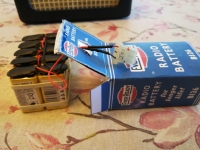 |
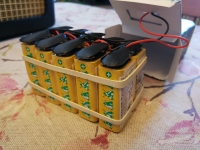 |
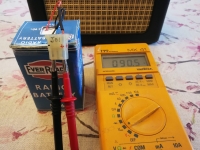 |
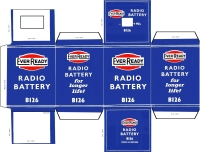 |
||
 Restauro
RestauroLa radio in realtà era funzionante, le valvole (DK96, DF96, DAF96 e DL96) una volta testate con il provavalvole TV-7U sono risultate tutte efficienti. Per tranquillità e vista la vetustà dell'apparecchio ho sostituito i due condensatori elettrolitici C19 e C20 (20 μF e 8 μF) rispettivamente con uno da 33 μF e uno da 10 μF ambedue da 300 V. Con l'occasione, visto che avevo tolto lo chassis dal mobile ho provveduto a togliere la polvere dall'altoparlante e a pulire la griglia frontale. Ho trattato il potenziometro del volume e il commutatore del cambio gamma con lo spray pulisci contatti, poi una volta rimontato l'apparecchio, l'ho alimentato con il mio alimentatore multitensione per controllarne il funzionamento e con piacere ho constatato che riceveva una vicina stazione in Onde Medie con segnale forte e chiaro. Per completare il lavoro e restituire alla R55 la portabilità non mi rimaneva che rintracciare delle batterie adatte per alimentarla. Ovviamente le pile a secco AD4 e B126 non sono più commercializzate da quasi mezzo secolo, perciò ho dovuto arrangiarmi. Per la bassa tensione la soluzione è stata relativamente facile, infatti ho potuto acquistare un porta batterie doppio per torcia da 1,5 V tipo D che ho modificato in modo che contenesse le batterie in parallelo anziché in serie. Ma poi ne ho inserito solo una perché la radio in effetti funzionava egregiamente a 1,5 V anche con una sola batteria. Per l'alta tensione la faccenda è stata un po' più laboriosa, ma una volta trovato in internet un disegno e le misure fisiche di una batteria Ever Ready B126 ho provveduto a stamparlo su cartoncino, ritagliare, ripiegare e incollare i bordi e ho ottenuto una scatola rettangolare dove sono riuscito a stipare 10 batterie alcaline da 9 V tipo 6LR61 che collegate in serie hanno fornito un totale di 90 V. Bisogna fare attenzione a non toccare i fili, le 6LR61 sono delle batterie piccole ma 10 collegate in serie sono in grado di provocare una dolorosa scossa! Una volta collegate tutte le batterie con connettori di fortuna e rispettando le giuste polarità la radio ha subito funzionato perfettamente, e con soddisfazione sono riuscito a sintonizzare varie emittenti in Onde Medie. IK3HIA © 2023 |
|||||
|
Schematics |
|||||
 |
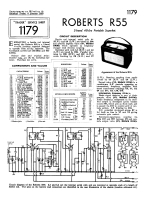 |
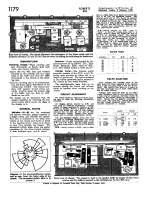 |
 |
||
|
Back to the top of the page |
|||||
|
|
|
Return to: IK3HIA page |
|
Return to Roberts Radio page
|